Many brands excel at converting visitors into customers with ecommerce content. But they often rely heavily on paid traffic, making growth expensive.
Strategic SEO content attracts qualified organic traffic, and reduces your reliance on paid ads. Done right, SEO isn’t just about getting seen in traditional search results. It’s a scalable revenue engine that helps customers discover your products through multiple channels, from Google to emerging AI platforms.
We’ve implemented this content strategy across many ecommerce brands. In one case, a client saw a 121.8% increase in revenue from organic search within six months of publishing our content regularly. More recently, that same client had a 272% increase in traffic – specifically from ChatGPT.
This guide breaks down what high-performing ecommerce content actually looks like. You’ll see proven formats, real ecommerce content marketing examples, and clear strategies to help turn organic traffic into consistent sales.
In this article:
Search is Changing. Is Your SEO Ready?
We specialize in reversing traffic drops and navigating search instability for profitable companies in competitive markets. Click below to learn about our award-winning SEO services.
What Makes Great SEO Content for Ecommerce?
Great ecommerce SEO content does more than rank. It brings in the right buyers by matching each page to what people are actually searching for.
Once they land, the content does the heavy lifting by answering the questions they’re already asking and making it easier to say yes.
Whether it’s sizing details, shipping timelines, or return policies, content that removes uncertainty increases conversion rates and average order values. When shoppers find clear, relevant answers before they even need to ask, you build trust that leads to long-term loyalty.
Exceptional ecommerce content converts visitors into customers by speaking directly to their needs and purchasing journey.
To create high-performing ecommerce content, these are the core principles to keep in mind:
- Alignment with user intent: Addressing the exact questions and needs that trigger customer searches.
- Strategic keyword optimization: Naturally integrating targeted keywords and relevant terms without sacrificing readability.
- Clear, structured organization: Presenting information clearly, making it easy to navigate and digest, for optimal technical performance and user experience (UX).
Understanding How SEO Works for an Ecommerce Website
SEO for ecommerce sites works best with a data-driven, site-wide approach. It requires optimizing individual pages for organic reach, and the site as a whole for both search performance and UX.
A strong ecommerce SEO strategy touches every layer of your site:
Product catalog organization: Group products into logical, user-friendly collections based on keyword research and buying behavior. For example, instead of one “Pajamas” category, break it down into collections based on search terms for different styles, seasons, or fabrics.

On-page SEO at scale: Each product and category page needs a unique, keyword-optimized title tag, meta description, and H1.
Templates can help automate the structure for large catalogs, but the content itself still needs to be distinct. Avoid copying the same description across multiple SKUs or product variations (like size or color). Even small tweaks like highlighting use cases, fabric feel, or styling suggestions can improve SEO performance and prevent pages from competing with each other.
Technical SEO essentials: Your store needs four key elements to perform well in search:
- Fast-loading pages that don’t keep shoppers waiting
- A mobile-friendly design that works on all devices
- Product data properly coded for search engines
- A logical site structure that helps both users and Google navigate your store
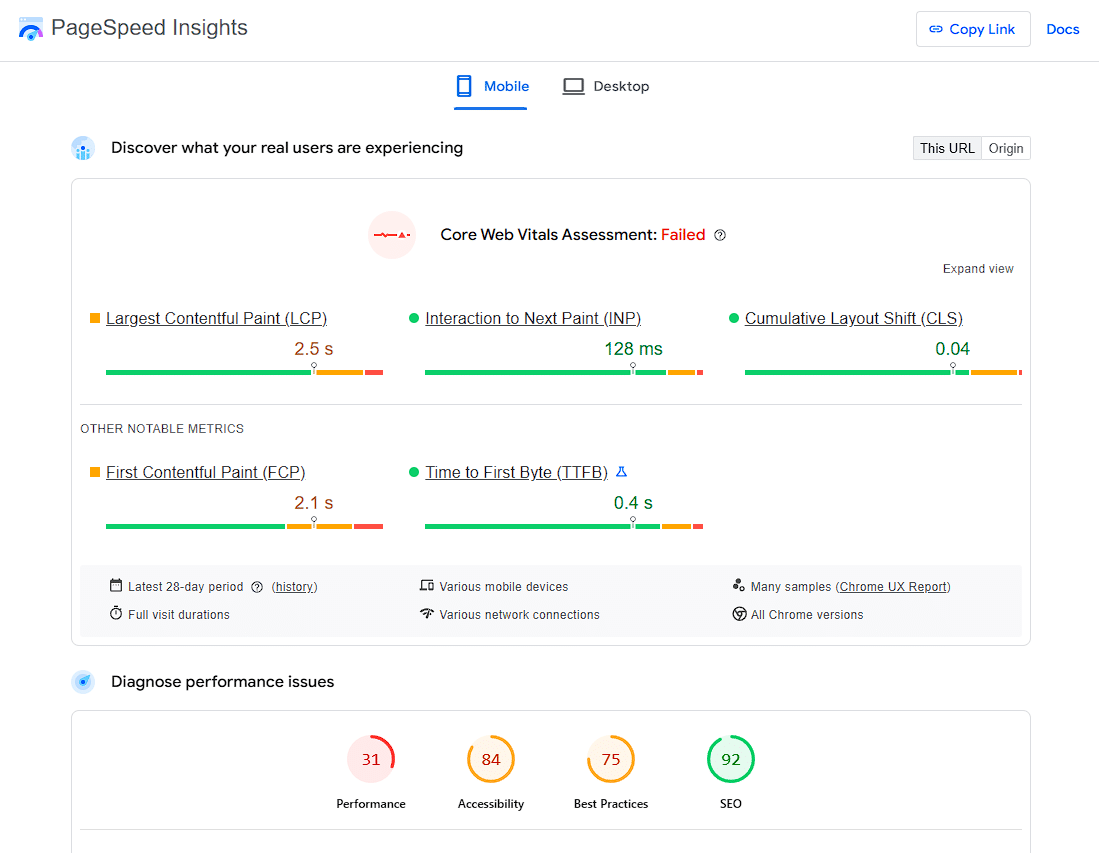
Keyword mapping: Think about how people search at different stages
- Shopping keywords (like “buy organic cotton pajamas”) should lead to product pages
- Research keywords (like “best pajamas for hot sleepers”) work better as blog posts or guides
This way, you meet shoppers with the right content at the right time. For example, someone researching “best pajamas for hot sleepers” isn’t ready to buy yet. They need helpful information first. A blog post can answer their questions and naturally introduce your products as the solution.
| Type of page | Target keyword |
|---|---|
| Homepage | Best Satin Pajamas for Women |
| Category Page | Women’s Pajamas |
| Product Page | Short PJ Set in Champagne & Caviar |
| Blog Post | How to Wash Cotton Pajamas & Satin Loungewear + DIY Detergent |
Bottom line: Each page serves a purpose, and it all works together to attract and convert.
Content Types That Work Well in Ecommerce SEO
High-performing ecommerce SEO uses content strategically across the buyer’s journey, from awareness to purchase. While product pages directly drive conversions, supportive content, such as blogs and buying guides, nurtures potential customers who aren’t yet ready to make a purchase.
By strategically deploying multiple content types across your conversion funnel, you build a content ecosystem that works at every stage of the buyer journey.

Product Pages
Too many ecommerce product pages are full of generic manufacturer copy, thin descriptions, and pay little consideration to how real customers search or shop.
Compelling product pages should do three things well:
- Communicate value clearly: Highlight what makes the product unique. Focus on benefits, not just features. Why does it matter that it’s organic cotton? How does the fit or material improve the user’s experience?
- Answer real customer questions: Include information that shoppers are actively looking for, such as sizing details, care instructions, shipping and return policies, or use-case suggestions (e.g., “perfect for summer travel” or “pairs well with our matching robe”).
- Make your product pages easy to find and read: Use natural language that includes related search terms throughout your page. Break up content with clear headings and bullet points. Write helpful image descriptions that include key product details. This makes your pages more visible in search while keeping them readable for customers.
Here’s an example of an optimized product page:

When done right, product page content becomes more than a description. It becomes a sales tool. Aligning copy with user intent and SEO best practices turns the casual browser into a confident buyer.
Category Pages
Ecommerce category pages do more than organize products. They help search engines understand your site and guide shoppers toward what they need.
A well-optimized category page includes content targeting long-tail phrases like “organic cotton PJs for women” or “petite pajama sets for travel.” This helps clarify the product range for users while improving search visibility for specific, purchase-ready terms.
Including brief FAQ sections can also improve performance. Questions like “What’s the difference between Eco Satin and organic cotton?” or “How do I choose the right size?” help capture informational queries and reduce customer hesitation.
Internal linking supports both SEO and UX. It improves crawlability, builds keyword clusters, and helps visitors discover related products and complementary categories.
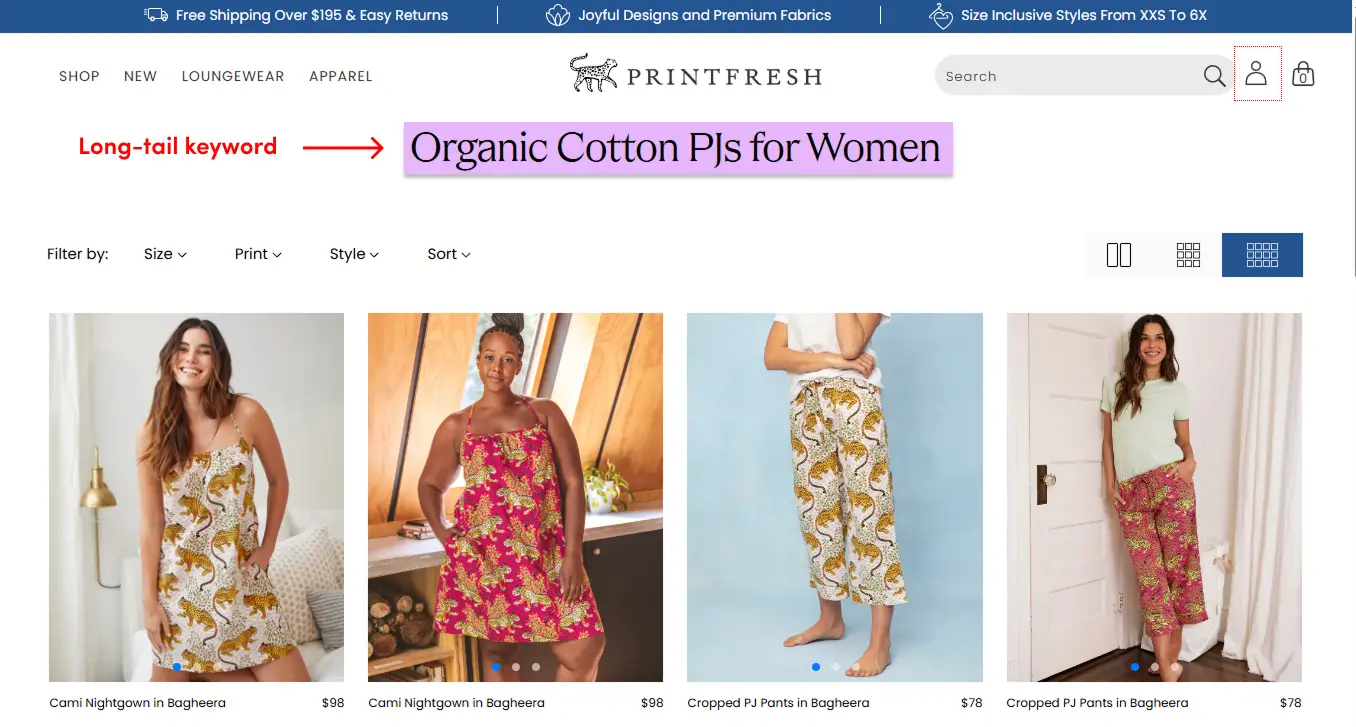
This helps guide users intuitively through your site, improving search visibility while keeping shoppers engaged and moving them closer to a purchase.
Blog Posts
Blog content plays a critical role in ecommerce SEO by attracting top-of-funnel traffic and guiding readers toward purchase decisions. But a blog can be more than a traffic driver. When done strategically, it becomes a conversion tool.
High-performing blog posts are built around real customer queries. Think “how to care for satin pajamas,” “what to pack for a summer wedding,” or “eco-friendly gift ideas for new moms.” These aren’t just informational; they align with products you sell and naturally introduce readers to relevant collections or items.
For example, a brand selling tuxedos might publish a guide titled “How to Wear a Tuxedo in Summer,” which ranks for seasonal long-tail keywords and links directly to lightweight tux options, accessories, and sizing guides. This type of content builds authority, captures search demand, and supports product discovery without a hard sell.
Blog posts also serve as powerful internal linking hubs. By connecting informational content to category pages, product listings, and FAQs, you strengthen site structure while improving UX and keeping visitors on-site longer.

Here’s a screenshot of a blog post built around a top-funnel customer query. It includes a clear headline, engaging copy, internal links to product pages, and a CTA that moves the reader closer to a purchase.
Landing Pages and Seasonal Campaigns
Dedicated landing pages are a key component of any strong ecommerce marketing strategy, especially when it comes to capitalizing on high-intent, time-sensitive search traffic. These include seasonal campaigns, product launches, and promotions tied to holidays or cultural moments.
While ecommerce homepage SEO needs to balance broad brand messaging with site navigation, custom landing pages focus on one goal: guiding visitors to a specific action. For ecommerce, this often means showcasing a product collection around a timely theme like “Holiday Gifts Under $50” or “Back-to-School Essentials.”
Well-optimized seasonal landing pages should include:
- A clear, benefit-driven headline tied to the campaign or occasion
- Keyword-rich copy that reflects how people actually search (e.g., “Halloween pajamas for women” or “matching family Christmas PJs”)
- Featured product listings with quick links to add to cart or learn more
- Internal links to related categories or gift guides to encourage exploration
For example, Printfresh created a dedicated landing page to promote their Summer Skirts collection. It targeted seasonal search terms like “lightweight summer skirts,” “cute summer skirts,” and “summer skirts for women.” The page featured breezy lifestyle imagery and engaging copy tailored to warm-weather styling.

Shoppers were guided to explore the full skirt collection as well as related categories like blouses, dresses, maxi skirts, and summer tops. This type of seasonal landing page connects timely search intent with curated product paths, making it easier for customers to complete their summer wardrobe in one place.
How to Find Inspiration for Your Ecommerce SEO Content
Consistently creating fresh and effective content can be challenging. Here are proven strategies for discovering high-potential content opportunities:
Use SEO Tools to Analyze Competitors
Identifying content your competitors rank for that you do not is one of the most effective ways to uncover proven, high-potential content opportunities. These insights show you exactly where competitors are winning traffic and where your site has room to grow. The following tools can help you do this:
Ahrefs
Ahrefs’ Content Gap tool shows you valuable opportunities you’re missing:
- Enter your website and a few competitor sites
- The tool shows you what search terms they rank for that you don’t
- Focus on keywords that have:
- Decent monthly searches
- Clear shopping intent
- Relevance to your products
This helps you spot exactly where you can gain ground on competitors.
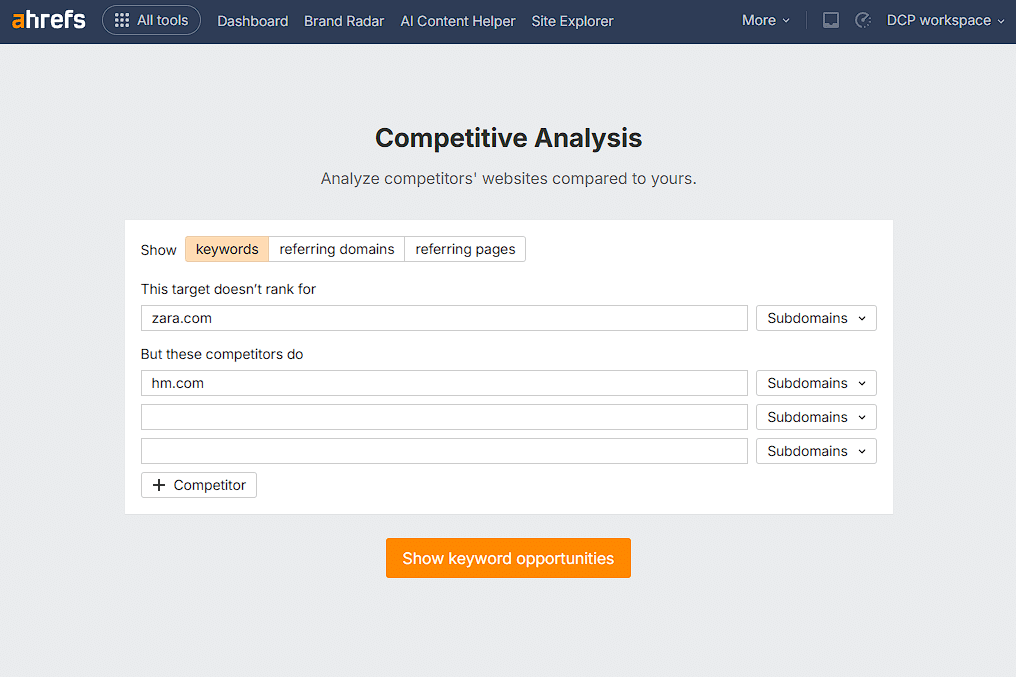
For example, if a competitor ranks for “best eco pajamas for summer” and you don’t, you may be missing a valuable page that serves both SEO and customer intent.
Semrush
Use the Keyword Gap tool under Competitive Research. Enter your domain and one or more competitors, then filter by “Missing” or “Weak” keywords. Prioritize those with strong relevance to your product catalog or blog strategy.
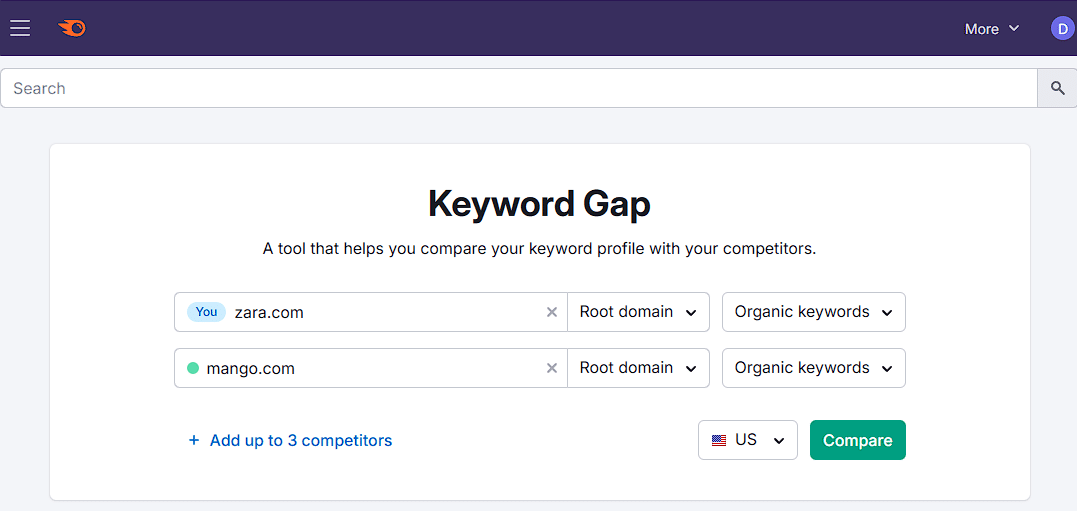
An example might be discovering that a competitor ranks for “how to wear a summer skirt,” and you have no related content. That can drive a new blog post or even a campaign landing page linked to your skirt collection.
These tools help you see beyond guesswork. You get a clear, competitor-tested roadmap to inform your next content moves.
Comprehensive Keyword Research
Strategic keyword research starts with identifying purchase-intent phrases that align with your product catalog. Tools like Ahrefs and Semrush help uncover high-converting queries such as “summer cotton skirts” or “organic pajamas for hot sleepers.”
In Semrush, you can use the Keyword Magic Tool to explore long-tail variations by entering a seed keyword like “summer skirts” and filtering by intent or keyword difficulty to find high-converting phrases.

Group keywords into clusters around product categories to guide content structure and internal linking.
For example, a “summer skirts” page could target “lightweight summer skirts,” “casual cotton skirts,” and “cute summer skirts for women.”
Effective keyword research ensures every page targets real demand and supports your bottom-line goals.
Plan Content Clusters
Once you have gathered keyword gaps, the next step is to turn those findings into a structured plan.
Start by organizing the keywords you uncovered into themes. Group informational queries like “how to care for organic cotton” into a blog content plan. Group product-focused or commercial-intent keywords like “summer skirts for women” or “cotton maxi skirts” into potential collection pages, landing pages, or product line expansions.
Also consider opportunities to support these core pieces with secondary content. For example, a main collection page for “lightweight summer skirts” can be supported with a blog post about “styling tips for beach-ready skirts” and an FAQ block about sizing or fabric types.
A well-executed content gap analysis ensures that your site speaks to more of your audience’s needs while building topical authority and improving overall visibility.
Look at SERP Features and Questions
Google’s search results page often contains more than just ten links. It reveals user intent, common questions, and preferred content formats. Paying close attention to Search Engine Results Page (SERP) features gives you valuable clues about what to include in your own content.
People Also Ask
When searching for a target keyword like “summer skirts for women,” the “People Also Ask” box typically includes questions your audience is already thinking about. These might include “What tops go with summer skirts?” or “Are maxi skirts good for summer?”
Use these questions as subheadings in your blog posts, answers in your FAQs, or topics for standalone guides to help people. They’ll improve your pages’ relevance and increase the chances of earning featured placement in the SERPs.
Featured Snippets
If a competitor ranks for a snippet you want, analyze how they format their content. Are they using lists, short paragraphs, or tables? Structure your content similarly, but make sure yours is more clear, complete, and relevant. Add a direct answer under a heading that mirrors the question to increase your snippet eligibility.
Visual Features
If a search term you’re looking to rank for returns image packs or video results, this signals a need for rich media. For ecommerce, this could mean adding lifestyle product images, styled outfit photos, or quick how-to videos showing fabric movement, outfit pairing, or unboxing.
By analyzing these SERP features, you align your content not just with keywords, but with how users want that information delivered. This can improve click-through rates and position your brand as the most helpful, relevant choice in the search results.
Real-World Examples of Effective Ecommerce SEO Content
Not all SEO strategies translate into revenue, but the best ones do. The following examples show what happens when ecommerce SEO is executed with a focus on user intent, content quality, and measurable outcomes.
These are some of the best ecommerce content marketing examples we’ve seen deliver direct revenue growth.
Scaling Sleepwear
This case study for a DTC sleepwear brand is an example of the explosive growth possible–even in a mature, highly competitive category–with a focused, SEO-first approach. By aligning product offerings with search intent and optimizing high-impact pages, the brand transformed sleepy collections into serious revenue drivers.
Even in established markets, a data-informed SEO strategy can uncover overlooked potential and deliver outsized results, increasing revenue without additional ad spend.
- Overview: Well-established luxury sleepwear brand with strong brand loyalty but limited organic visibility in core pajama-related searches.
- Strategies: Expanded underperforming collections based on search demand, optimized on-page content and internal linking, and improved navigation for both users and search engines.
- Results: 6,008 new keyword rankings and 3,800 pajama-related keywords improved in just one quarter, organic revenue +103% YoY, and organic share of total revenue grew from 36% to 54%.
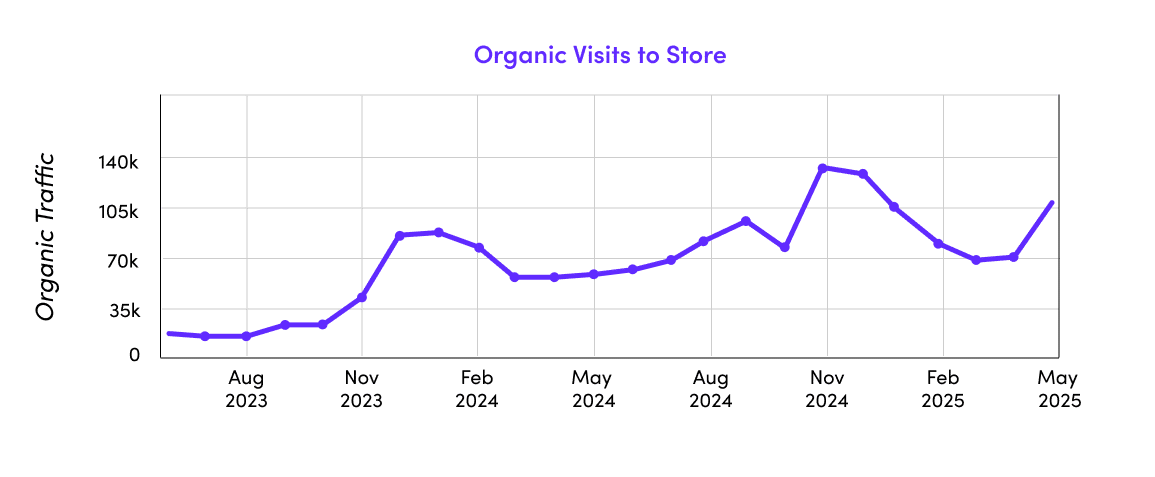
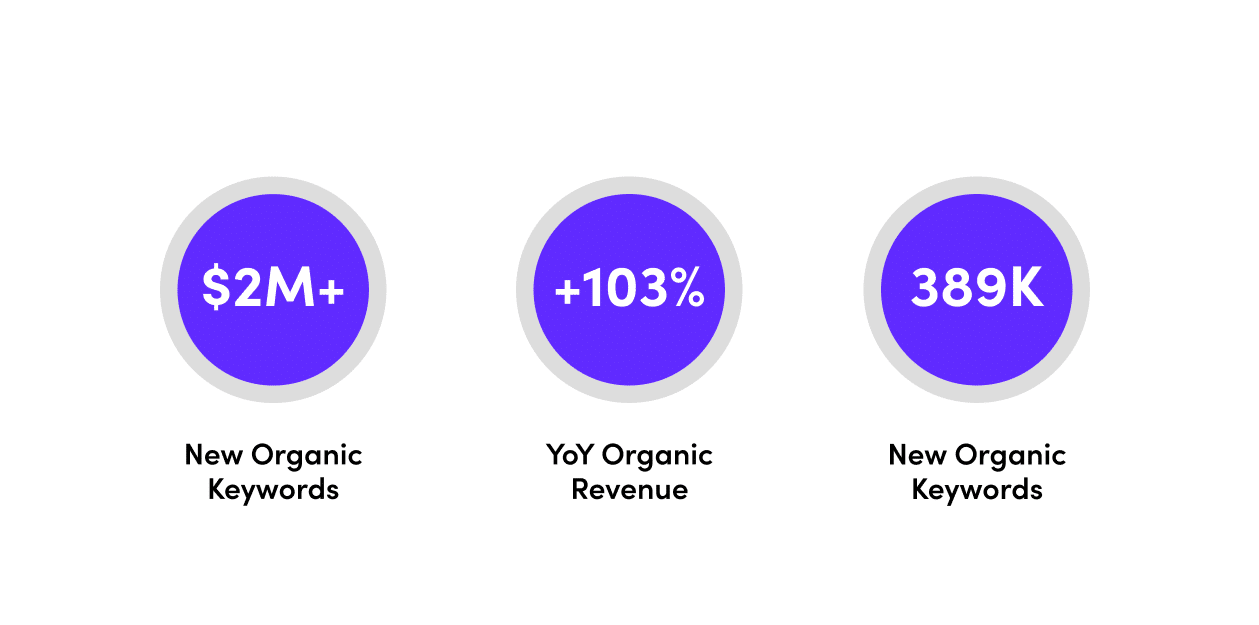
Seven Sons
This case study is compelling because it connects SEO strategy directly to revenue. Rather than chasing traffic for traffic’s sake, the focus was on improving traffic quality and aligning content with real customer intent.
It’s a clear example of how mission-driven ecommerce brands can leverage SEO to outperform larger competitors and drive meaningful growth through structured, values-aligned content.
- Overview: Ethical farm-to-table meat supplier.
- Strategies: Created a detailed Learning Hub addressing customer FAQs and objections, and optimized product pages.
- Results: Achieved a 121% YoY revenue increase, dominated organic rankings for competitive keywords, and significantly increased chicken and lamb product sales.

DTC Ecommerce Brand
This DTC case study demonstrates how a sustainable SEO strategy can deliver major gains in a competitive, highly sensitive niche. By combining low-risk site restructuring with targeted content optimization, the brand gained visibility in search, while enhancing UX and conversion paths.
The results prove that even in a saturated ecommerce vertical, strategic SEO can unlock measurable, long-term growth without disrupting what’s already working.
- Overview: Established brand in the sensitive adult wellness niche.
- Strategies: Reorganized product collections, executed targeted keyword mapping, and significantly enhanced on-page SEO.
- Results: Secured Page 1 rankings for 27 out of 47 wishlist keywords, attracted over 480K organic sessions, and achieved consistent quarter-over-quarter growth.
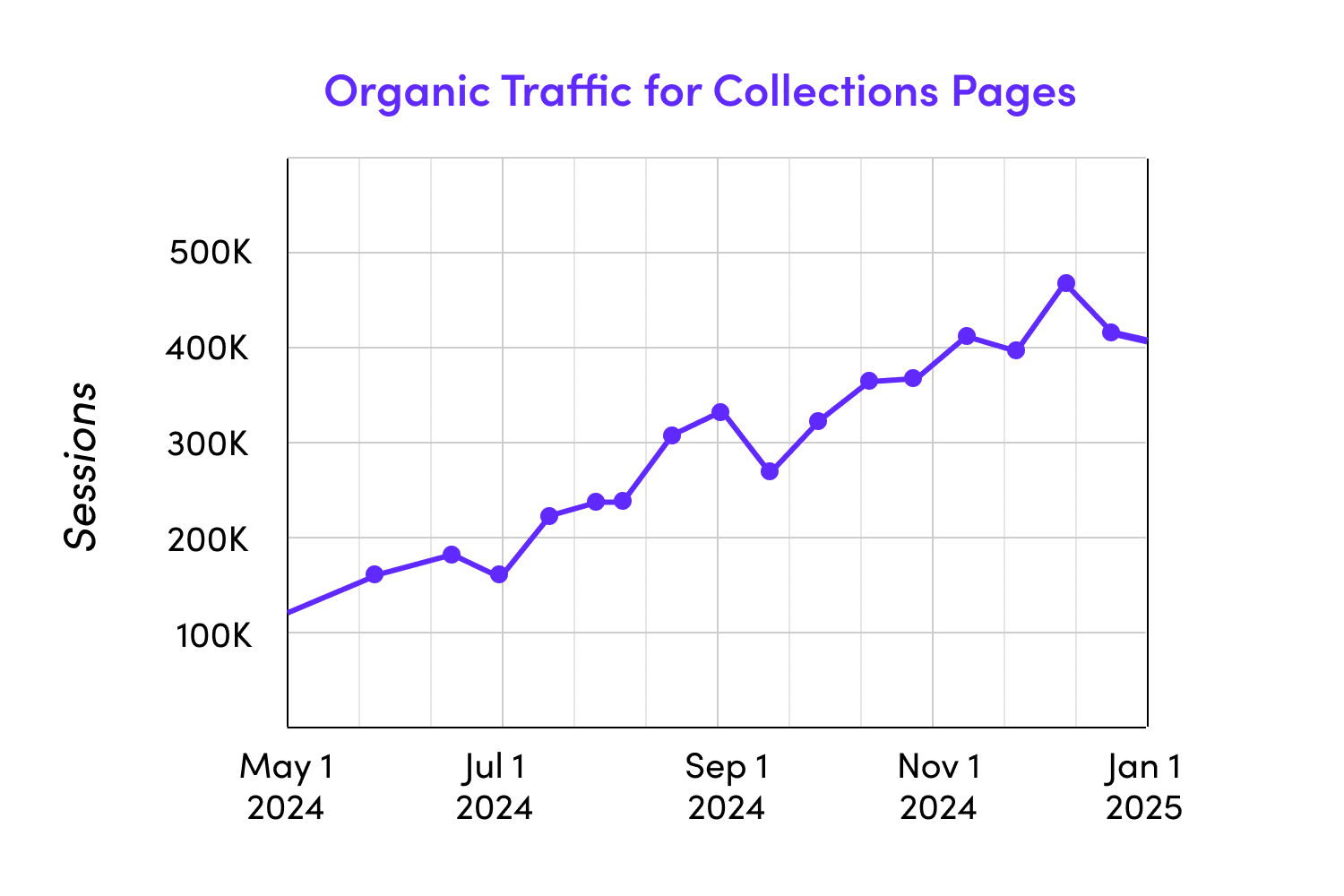
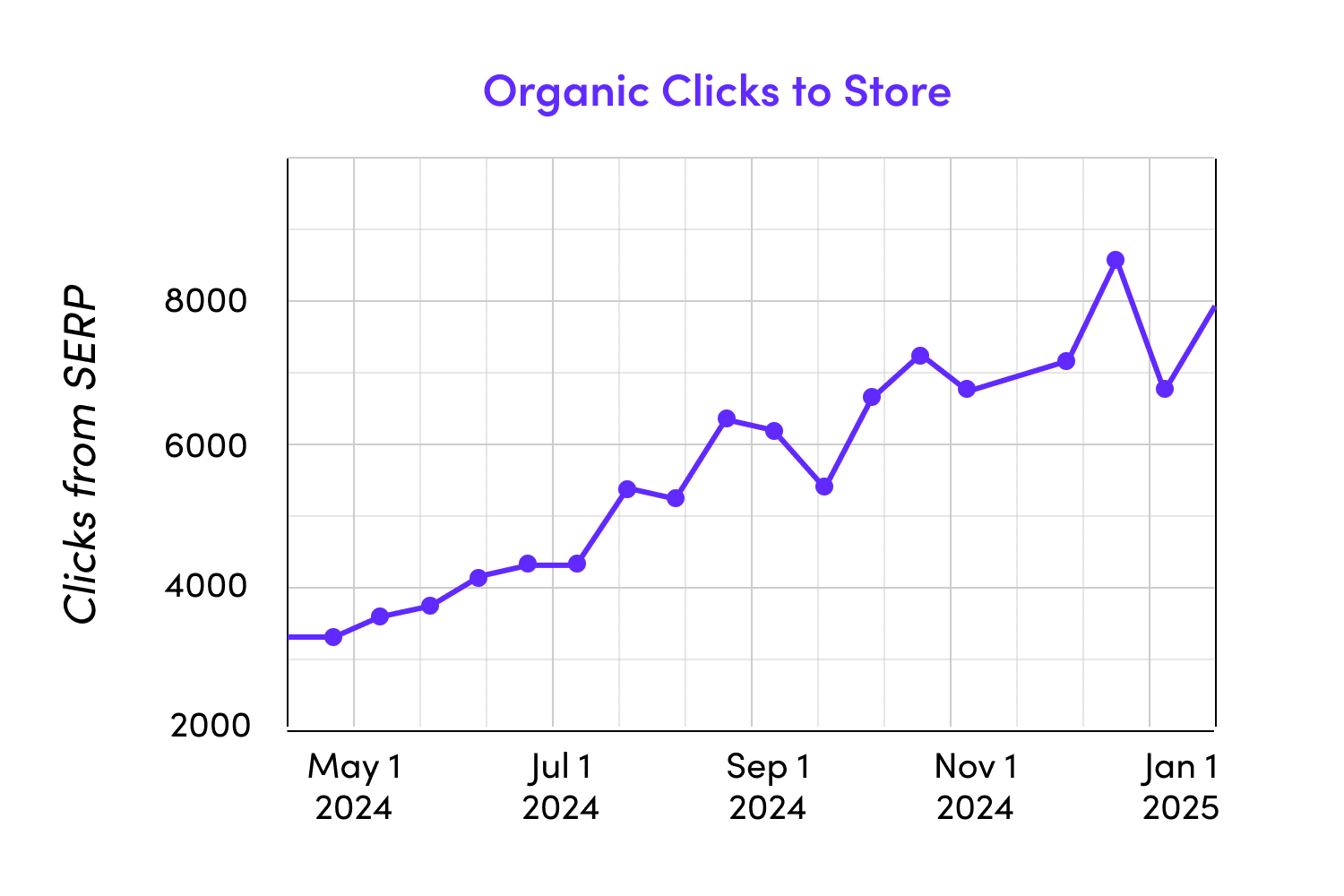
Common Pitfalls in Ecommerce SEO Content and How to Avoid Them
Even solid ecommerce content can miss the mark if it ignores search intent or skips key optimizations. These common mistakes can limit visibility, reduce conversions, and hurt long-term growth.
Here’s what to watch for and how to avoid them.
Duplicate or Thin Content
Copying manufacturer descriptions or using the same boilerplate text across pages signals low value to both users and search engines.
For example, a product page that says “100% cotton, machine washable, available in sizes XS–XL” tells the shopper almost nothing about fit, fabric feel, or use cases.
Instead, focus on creating unique, benefit-driven copy. Describe who the product is for, when to wear it, and why it stands out. If two products are similar, emphasize their differences to avoid duplication and potential cannibalization.
Over-Optimization
Keyword stuffing can tank your rankings. Repeating “summer skirts” ten times in a short paragraph makes your content unreadable and signals manipulation to Google.
Instead, use natural language and semantic variations. For example, “lightweight cotton skirts” or “breezy summer styles” help reinforce context without overloading your content. Write for your customer first, then refine for search.
Good SEO doesn’t draw attention to itself. It just feels helpful.
Ignoring Search Intent
A product page should convert, not educate. A blog post should build trust, not pitch.
Even well-optimized content can fail if it doesn’t match what the user actually wants. A blog post targeting “best cotton pajamas” that only talks about fabric types, without showing or linking to actual products, misses the mark.
Map content to the right stage of the buyer journey. Use top-of-funnel content like guides and style tips for early research, and optimize category or product pages for people ready to buy.
When in doubt, ask: “What would the searcher expect to see here?”
Ready to Transform Your Ecommerce SEO?
SEO content that drives real revenue requires constant evolution. The brands that win don’t just rank, they connect with customers through strategic content at every stage of the buying journey.
Doing this is beyond effective, but it’s also time-consuming, especially when you have a thousand other things to worry about while running your business.
But that’s where we come in. At DCP, we specialize in ecommerce SEO and the revenue-driving content that goes with it. We’ve helped countless clients optimize their stores and boost their sales, and we can help you, too.
So if you’re ready to resurrect your ecommerce business and transform it into a genuine revenue growth machine, let’s talk.
Explore our Ecommerce SEO Services and put these proven strategies to work for your business.

